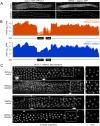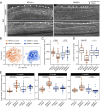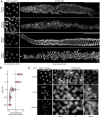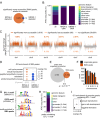This is a preprint.
RNA Pol I activity maintains chromatin condensation and the H3K4me3 gradient essential for oogenesis, independent of ribosome production
- PMID: 40463076
- PMCID: PMC12132276
- DOI: 10.1101/2025.05.07.652530
RNA Pol I activity maintains chromatin condensation and the H3K4me3 gradient essential for oogenesis, independent of ribosome production
Abstract
Oogenesis requires extensive and dynamic chromatin remodeling that primes gene promoters for later transcriptional activation during embryonic development. Here, we uncover a pivotal, non-canonical role for RNA Polymerase I (Pol I) in driving these chromatin state transitions during Caenorhabditis elegans oogenesis. Using the auxin-inducible degron system to selectively deplete either a Pol I-specific catalytic subunit or a ribosome assembly factor, we disentangle the consequences of impaired nucleolar integrity from reductions in ribosome biogenesis. Strikingly, although disrupting ribosome assembly caused minimal effects on oocyte production, loss of nucleolar structure via Pol I depletion led to severe meiotic chromosome abnormalities, widespread changes in chromatin accessibility, and a dampening of the typical distal-proximal H3K4me3 gradient required for oogenesis, resulting in fewer but significantly larger oocytes. Despite their promoters becoming more accessible, oogenesis genes did not show large changes in steady-state mRNA, consistent with transcriptional repression prior to fertilization. Instead, Pol I depletion prematurely remodeled oogenic chromatin, through a misdirection of H3K4me3 deposition towards promoters normally primed for zygotic genome activation. These findings reveal an epigenetic gating function for nucleolar integrity in oocyte maturation: Pol I preserves three-dimensional chromatin organization and maintains proper spatiotemporal regulation of histone modifications, independent of ribosome production. Given the evolutionary conservation of nucleolar dynamics and histone modifications during gametogenesis, our work suggests that nucleolar stress, whether from environmental factors, aging, or genetic disorders, could broadly compromise fertility by disrupting oogenic chromatin priming.
Conflict of interest statement
DECLARATION OF INTERESTS The authors declare no competing interests.
Figures






Similar articles
-
Characterization of the distribution and dynamics of chromatin states in the C. elegans germline reveals substantial H3K4me3 remodeling during oogenesis.Genome Res. 2024 Feb 7;34(1):57-69. doi: 10.1101/gr.278247.123. Genome Res. 2024. PMID: 38164610 Free PMC article.
-
RNA polymerase I is essential for driving the formation of 3D genome in early embryonic development in mouse, but not in human.Genome Med. 2025 May 19;17(1):57. doi: 10.1186/s13073-025-01476-y. Genome Med. 2025. PMID: 40390095 Free PMC article.
-
CFP1 Regulates Histone H3K4 Trimethylation and Developmental Potential in Mouse Oocytes.Cell Rep. 2017 Aug 1;20(5):1161-1172. doi: 10.1016/j.celrep.2017.07.011. Cell Rep. 2017. PMID: 28768200
-
Linker histone transitions during mammalian oogenesis and embryogenesis.Dev Genet. 1998;22(1):17-30. doi: 10.1002/(SICI)1520-6408(1998)22:1<17::AID-DVG3>3.0.CO;2-A. Dev Genet. 1998. PMID: 9499577 Review.
-
Oocyte maturation: gamete-somatic cells interactions, meiotic resumption, cytoskeletal dynamics and cytoplasmic reorganization.Hum Reprod Update. 2015 Jul-Aug;21(4):427-54. doi: 10.1093/humupd/dmv011. Epub 2015 Mar 4. Hum Reprod Update. 2015. PMID: 25744083 Review.
References
Publication types
Grants and funding
LinkOut - more resources
Full Text Sources
